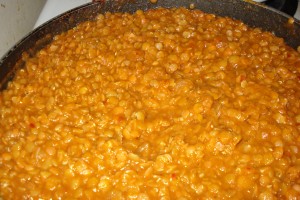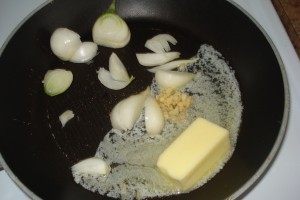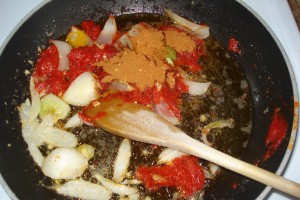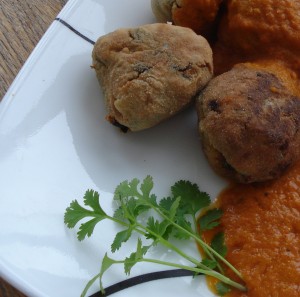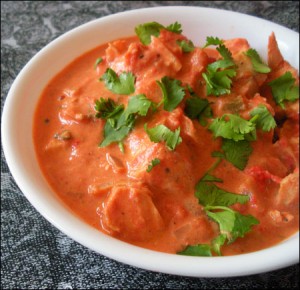As a fan of most varieties of curry, those belonging to the oeuvre of Thai cuisine certainly have not escaped my culinary notice. The light and tangy flavors of citrus, coconut and cilantro make Thai curries uniquely delicious. Unfortunately, traditional Thai cooking methods make the cooking of Thai curries uniquely inconvenient.
The endeavor of getting into any kind of curry cookery for the Western hobby chef involves a “collection period” of stocking up on the specific, previously-exotic ingredients commonly involved in curry recipes (I say “previously” because things like turmeric, methi and tamarind are now staples of my spice cabinet). For Indian curries, I have such a vast collection of spices and seasonings on hand, now, that I can simply go down a list of recipe ingredients and toss in what I need as easily as I toss basil, oregano and parsley into a marinara sauce.
The problem with Thai curries is that most recipes rely on a tradition of curry paste making. The result is that, in nearly all Thai recipe books I have found, it becomes necessary first to make a quantity of a particular Thai curry paste, only a portion of which will be used in the recipe. This strategy certainly seems like a good idea for those chefs who make Thai curries with any sort of frequency, but for a hobby chef who wants to experiment with different curries (thus requiring different pastes), the workload of making all the pastes ahead of time leads to my easily talking myself out of making Thai curries.
 Authentic cooking methods are all well and good for people who prize them and relish in the process, but if a particular cooking method becomes a roadblock for a busy professional, I’m all in favor of eschewing authenticity for convenience. In other words, if the trouble of sticking to authenticity is going to prevent you from making it at all, what’s the point? However, when approaching Thai curry, I didn’t want to eschew authenticity so far as to use store-bought pastes. I have no problem collecting the ingredients, I just wanted to use recipes for Thai curry with the same ease as I use recipes for Indian curry: go down a list of ingredients and toss them in.
Authentic cooking methods are all well and good for people who prize them and relish in the process, but if a particular cooking method becomes a roadblock for a busy professional, I’m all in favor of eschewing authenticity for convenience. In other words, if the trouble of sticking to authenticity is going to prevent you from making it at all, what’s the point? However, when approaching Thai curry, I didn’t want to eschew authenticity so far as to use store-bought pastes. I have no problem collecting the ingredients, I just wanted to use recipes for Thai curry with the same ease as I use recipes for Indian curry: go down a list of ingredients and toss them in.
And so, I resolved that I would take my favorite Thai cookbook and resolve the paste and curry recipes into one. After all, many of the ingredients were in both the paste and the curry, why couldn’t I just add them in one by one?
I enlisted Sabrina to come over and help as both my chronicler and my sounding board as I went down the list of ingredients for each curry and its corresponding paste in effort to make each curry without the extra step of formulating the paste ahead of time. Sabrina, being more of a traditionalist in terms of cookery, was dubious about my efforts, but game to come along for the ride.
It should also be noted that I also make a few specific ingredient substitutions in the interest of convenience and freshness. Keeping kaffir lime leaves and fresh lemongrass on hand is not the easiest (or cheapest) thing for a Western city girl to do, so I prefer to substitute lime and lemon zest to create a fresh flavor, rather than resorting to dried versions of the original ingredients.
The first recipe we tackled was for Massaman curry, which we decided would contain chicken only. Sabrina found the end result to be a bit too lemon-y, but I didn’t think one way or other about the lemon flavor, so I’m including a range for the lemon zest; I zested 1/2 a lemon, but feel free to use any smaller amount. In general, the particular ingredient amounts were decided upon off-the-cuff, so using a little more or a little less to taste is certainly within the reasonable realm of creative freedom.
SARAH’S NO-PASTE MASSAMAN CURRY
1 or 2 tablespoons vegetable oil
1 onion, chopped or diced
2 teaspoons minced garlic
1 tablespoon ground ginger (or more to taste)
2 dried red chilis, pulverized with a mortar and pestle
zest of 1/4 to 1/2 of a lemon peel, shredded finely (invest in an OXO Zester, and you won’t regret it)
1/2 teaspoon ground galangal (can’t find it at the store? Try Penzey’s)
1/2 teaspoon ground cloves
1/2 teaspoon ground cinnamon
12 cardamom seeds, pulverized with a mortar and pestle
pinch of nutmeg or mace
several dashes of fish sauce
2 tablespoons brown sugar
2 tablespoons tamarind paste (I use Tamicon)
1 (13-15 oz) can of coconut milk
beef, chicken, other meat cubed, mixed vegetables or other protein
peanuts
Saute onion, garlic and ginger in vegetable oil for a few minutes. Powder the red chilis and the cardamom seeds in a mortar and pestle (or substitute already powdered versions of each). Add the chilis, lemon zest, galangal, cloves, cinnamon, cardamom, and nutmeg to the saucepan. Sprinkle in the fish sauce. Add the brown sugar and tamarind paste. Pour in the coconut milk. At this point, you have your curry sauce and meat can be added. If using meat, simmer covered for a few hours until meat reaches desired tenderness. If adding vegetables, cook them to desired tenderness in the sauce. Add peanuts right before serving.
A few of my guests did note the fact that traditional Massaman curry usually includes potatoes. I generally avoid potatoes in recipes because of the unabashed carbohydrate content they add. Cubed potatoes could, however, easily be added to this Massaman curry. One would simply need to contribute additional liquid (water or broth) to the curry as the potatoes inevitably absorbed the curry sauce during cooking.
 Next up we decided to try a green curry, which would contain both chicken and vegetables. I treat all of my curry recipes as sauces, which could be used over any meat, protein or vegetable, and so these Thai curries are no exception. As a result, I don’t specify exact amounts of meat or vegetables, and further I don’t specify exact vegetables. Chefs should simply put as much in as seems a logical ratio for the amount of sauce. This choice contains a certain amount of creative freedom, as some people may prefer their curries drier and some may prefer them more saucy. I leave it up to you. Again, this approach might not be the most authentic, but it is an easy and convenient way to cook. I put Sabrina in charge of procuring the meat and the vegetables for this one. She came up with boneless chicken thighs (as she and Ted do not eat beef) and fresh broccoli, bell peppers and carrots. I saved the broccoli for our third, all vegetable curry, but did contribute carrots and bell peppers to the green curry along with about a third of the package of chicken (two thirds went in the massaman curry).
Next up we decided to try a green curry, which would contain both chicken and vegetables. I treat all of my curry recipes as sauces, which could be used over any meat, protein or vegetable, and so these Thai curries are no exception. As a result, I don’t specify exact amounts of meat or vegetables, and further I don’t specify exact vegetables. Chefs should simply put as much in as seems a logical ratio for the amount of sauce. This choice contains a certain amount of creative freedom, as some people may prefer their curries drier and some may prefer them more saucy. I leave it up to you. Again, this approach might not be the most authentic, but it is an easy and convenient way to cook. I put Sabrina in charge of procuring the meat and the vegetables for this one. She came up with boneless chicken thighs (as she and Ted do not eat beef) and fresh broccoli, bell peppers and carrots. I saved the broccoli for our third, all vegetable curry, but did contribute carrots and bell peppers to the green curry along with about a third of the package of chicken (two thirds went in the massaman curry).
SARAH’S NO-PASTE GREEN CURRY
1 or 2 tablespoons vegetable oil
1 onion, chopped or diced
2 teaspoons minced garlic
1 tablespoon ground ginger (or more to taste)
2 green chilis, diced
1/4 teaspoon ground coriander seed
1/4 teaspoon cumin
1 teaspoon ground galangal
zest of 1/2 lemon peel, shredded finely
zest of one lime peel, shredded finely
1/2 cup fresh cilantro leaves, chopped
1/4 to 1/3 cup fresh basil leaves, chopped
1 tablespoon brown sugar
several dashes of fish sauce
1 (13-15 oz) can coconut milk
your choice of meat cubed, mixed vegetables or other protein
Saute onion, garlic, ginger and chilis in vegetable oil for a few minutes. Add coriander, cumin, galangal, lemon zest, lime zest, cilantro and basil. Stir in brown sugar, fish sauce and coconut milk. At this point, depending on how finely you chopped the fresh herbs and chilis, you may want to process this sauce to a smoother consistency. I am a whole-hearted devotee of the immersion blender, as it will accomplish most such tasks in the kitchen without the necessity of dirtying the food processor bowl in addition to the cooking pot. If, however, you are one of the unfortunate class of Americans who do not own an immersion blender, you can always just transfer your sauce to a food processor. If you prefer to be proactive about it, you can take all the ingredients up to and including the coconut milk, combine them in your food processor, and then heat in the saucepan.
Once sauce is desired smoothness, add the meat, if using. If using a combination of meat and vegetables, like we did, the meat should be added first, cooked until tender, and then vegetables should be added and they can simmer together until the vegetables are done. I prefer curry meat to be so tender it easily falls apart under my fork, so there is no such thing for me as meat that is too well stewed.
The green curry turned out to be the standout favorite of the group; not only did it receive numerous accolades, but it was the only curry pan cleaned out by the end of dinner. A note on the green-ness of green curry. I’m ordinarily all in favor or using the dried versions of herbs and spices for the sake of convenience, but green curry is one of those dishes that absolutely requires fresh green herbs. If you don’t use fresh cilantro and basil, the curry will not turn out green and, I venture to say, will not turn out very tasty at all. The fresh herbs really make this dish; increasing proportions of these herbs to taste is never a bad idea.
Sabrina and I had the first two curries well on their way by the time Ted and Roger arrived for dinner, so we let the boys have a say in our final curry of the night. We had already planned for this one to be an all-vegetable curry (after all, the meat supply was exhausted at this point), but had not decided upon the sauce. In the interest of sticking with basic curry recipes, the success of which we could measure from the experience of having tasted versions of these curries before, I put all the more unusual and specialty Thai curry recipes in the book off limits. Our choices, then, were yellow curry, red curry or panang curry. The scales tipped to panang and we were off and running.
 Panang curry is the one type of Thai curry I have made a few times before with good success. Because of this fact, I took the liberty of using my own approach to the recipe. In the past, I have basically treated panang as a red curry with peanut, and so instead of drawing from the peanut-based paste, I based this recipe off of the red curry paste, as well as the recipes for panang and for red curry.
Panang curry is the one type of Thai curry I have made a few times before with good success. Because of this fact, I took the liberty of using my own approach to the recipe. In the past, I have basically treated panang as a red curry with peanut, and so instead of drawing from the peanut-based paste, I based this recipe off of the red curry paste, as well as the recipes for panang and for red curry.
SARAH’S NO-PASTE PANANG CURRY
1 or 2 tablespoons vegetable oil
1 onion, chopped or diced
2 teaspoons minced garlic
1 tablespoon ground ginger (or more to taste)
10 dried red chilis, pulverized in a mortar and pestle
zest of 1/4 lemon peel, shredded finely
zest of one lime peel, shredded finely
1/2 teaspoon galangal
1/2 teaspoon ground coriander
several dashes of fish sauce
a few squirts of sriracha sauce
1 tablespoon brown sugar
1 tablespoon tamarind paste
1 (13-15 oz) can of coconut milk
1/4 to 1/2 cup natural peanut butter
your choice of meat cubed, mixed vegetables or other protein
chopped cilantro, to garnish
peanuts, to garnish
Saute onion, garlic and ginger in vegetable oil for a few minutes. Powder the red chili with a mortar and pestle, or substitute already powdered chilis. Add lemon zest, lime zest, galangal, ground coriander, fish sauce, tamarind paste, coconut milk and peanut butter. Stir over medium fire until well combined.
Add the meat first, if using, and cook to desired tenderness. Add vegetables, if using, and simmer until tender. Garnish with cilantro and peanuts.
The panang curry went over well with all dinner guests. Sabrina mentioned that it was a little peanut-ty for her taste, but acknowledged that such level of peanut flavor was likely not contrary to the nature of the dish, but rather just not to her personal taste. As a result, I built some flexibility into the above recipe; feel free to include less peanut butter for a lighter peanut taste, or more for a thorough peanut taste.
All in all, the No-Paste Thai Curry Experiment was a success; Sabrina expressed congenial surprise that it all turned out so well when the endeavor seemed so free-form at the start. All three curries were much enjoyed with the jasmine rice and Bota Box Chardonnay brought by Sabrina.
One footnote to this curry meal—when everyone arrived and started drinking, we quickly realized that the not-so-imminent readiness of the curries might spell disaster with drinks on an empty stomach. To keep the booze from flooding so quickly to our heads we’d be drunk by dinner, I set out some mango cheese spread and crackers, left over from the holidays. The improvised appetizer was an unintentional hit! This spread doesn’t properly belong to any type of Asian cuisine, but it is curry-inspired, so for the sake of completeness, here it is:
SARAH’S MANGO CHEESE SPREAD
1 (8 oz) package of cream cheese
1/4 cup mango chutney
1 small onion, chopped
1/2 cup unsalted, blanched nuts (almonds, cashews, etc)
2 teaspoons ground ginger
2 teaspoons garam masala
1 teaspoon turmeric
1/4 teaspoon cinnamon
1/4 teaspoon cardamom
Combine all ingredients in a food processor and puree until smooth. Chill at least two hours before serving.
 I find that I like pumpkin a lot, just not in pies. As with sweet potatoes, I’m a bigger fan of savory dishes than sweet, so when pumpkin is readily available in the autumn months, I usually stock up on cans of it to keep me into the next year. While this curry recipe is not exactly “from scratch,” it could be if you used homemade curry paste, but I was feeling lazy and happened to have some store-bought paste in my cupboard. I used a combination of chicken and vegetables because I was short of meat, and it turned out quite tasty.
I find that I like pumpkin a lot, just not in pies. As with sweet potatoes, I’m a bigger fan of savory dishes than sweet, so when pumpkin is readily available in the autumn months, I usually stock up on cans of it to keep me into the next year. While this curry recipe is not exactly “from scratch,” it could be if you used homemade curry paste, but I was feeling lazy and happened to have some store-bought paste in my cupboard. I used a combination of chicken and vegetables because I was short of meat, and it turned out quite tasty. 